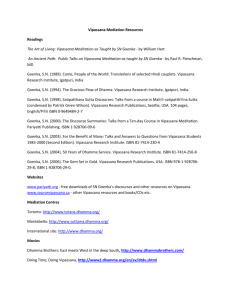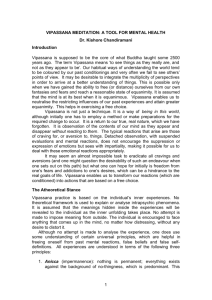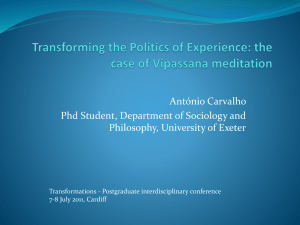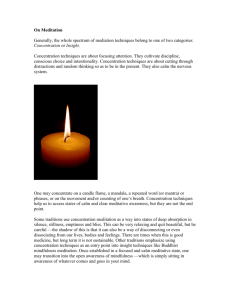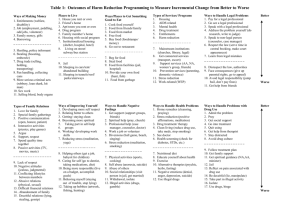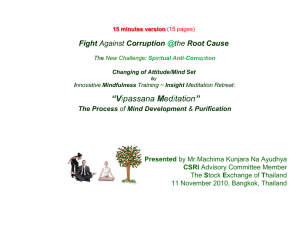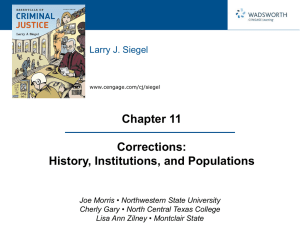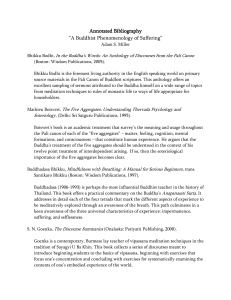FACT SHEET - Vipassana Meditation Courses For Correction Facilities
advertisement
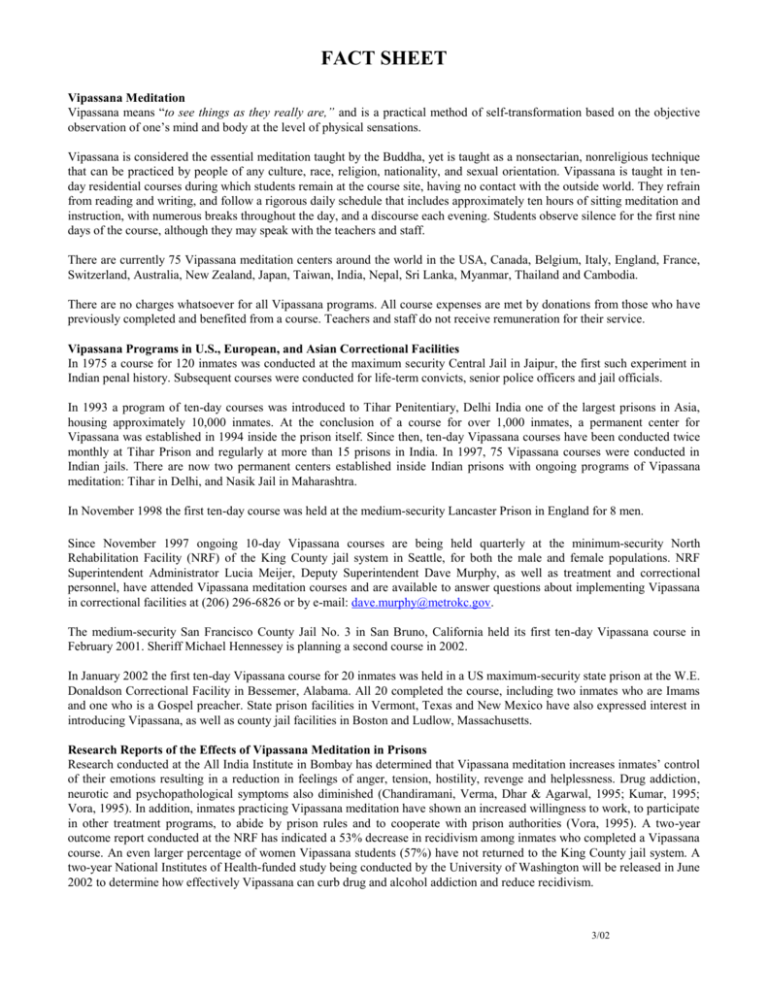
FACT SHEET Vipassana Meditation Vipassana means “to see things as they really are,” and is a practical method of self-transformation based on the objective observation of one’s mind and body at the level of physical sensations. Vipassana is considered the essential meditation taught by the Buddha, yet is taught as a nonsectarian, nonreligious technique that can be practiced by people of any culture, race, religion, nationality, and sexual orientation. Vipassana is taught in tenday residential courses during which students remain at the course site, having no contact with the outside world. They refrain from reading and writing, and follow a rigorous daily schedule that includes approximately ten hours of sitting meditation and instruction, with numerous breaks throughout the day, and a discourse each evening. Students observe silence for the first nine days of the course, although they may speak with the teachers and staff. There are currently 75 Vipassana meditation centers around the world in the USA, Canada, Belgium, Italy, England, France, Switzerland, Australia, New Zealand, Japan, Taiwan, India, Nepal, Sri Lanka, Myanmar, Thailand and Cambodia. There are no charges whatsoever for all Vipassana programs. All course expenses are met by donations from those who have previously completed and benefited from a course. Teachers and staff do not receive remuneration for their service. Vipassana Programs in U.S., European, and Asian Correctional Facilities In 1975 a course for 120 inmates was conducted at the maximum security Central Jail in Jaipur, the first such experiment in Indian penal history. Subsequent courses were conducted for life-term convicts, senior police officers and jail officials. In 1993 a program of ten-day courses was introduced to Tihar Penitentiary, Delhi India one of the largest prisons in Asia, housing approximately 10,000 inmates. At the conclusion of a course for over 1,000 inmates, a permanent center for Vipassana was established in 1994 inside the prison itself. Since then, ten-day Vipassana courses have been conducted twice monthly at Tihar Prison and regularly at more than 15 prisons in India. In 1997, 75 Vipassana courses were conducted in Indian jails. There are now two permanent centers established inside Indian prisons with ongoing programs of Vipassana meditation: Tihar in Delhi, and Nasik Jail in Maharashtra. In November 1998 the first ten-day course was held at the medium-security Lancaster Prison in England for 8 men. Since November 1997 ongoing 10-day Vipassana courses are being held quarterly at the minimum-security North Rehabilitation Facility (NRF) of the King County jail system in Seattle, for both the male and female populations. NRF Superintendent Administrator Lucia Meijer, Deputy Superintendent Dave Murphy, as well as treatment and correctional personnel, have attended Vipassana meditation courses and are available to answer questions about implementing Vipassana in correctional facilities at (206) 296-6826 or by e-mail: dave.murphy@metrokc.gov. The medium-security San Francisco County Jail No. 3 in San Bruno, California held its first ten-day Vipassana course in February 2001. Sheriff Michael Hennessey is planning a second course in 2002. In January 2002 the first ten-day Vipassana course for 20 inmates was held in a US maximum-security state prison at the W.E. Donaldson Correctional Facility in Bessemer, Alabama. All 20 completed the course, including two inmates who are Imams and one who is a Gospel preacher. State prison facilities in Vermont, Texas and New Mexico have also expressed interest in introducing Vipassana, as well as county jail facilities in Boston and Ludlow, Massachusetts. Research Reports of the Effects of Vipassana Meditation in Prisons Research conducted at the All India Institute in Bombay has determined that Vipassana meditation increases inmates’ control of their emotions resulting in a reduction in feelings of anger, tension, hostility, revenge and helplessness. Drug addiction, neurotic and psychopathological symptoms also diminished (Chandiramani, Verma, Dhar & Agarwal, 1995; Kumar, 1995; Vora, 1995). In addition, inmates practicing Vipassana meditation have shown an increased willingness to work, to participate in other treatment programs, to abide by prison rules and to cooperate with prison authorities (Vora, 1995). A two-year outcome report conducted at the NRF has indicated a 53% decrease in recidivism among inmates who completed a Vipassana course. An even larger percentage of women Vipassana students (57%) have not returned to the King County jail system. A two-year National Institutes of Health-funded study being conducted by the University of Washington will be released in June 2002 to determine how effectively Vipassana can curb drug and alcohol addiction and reduce recidivism. 3/02
